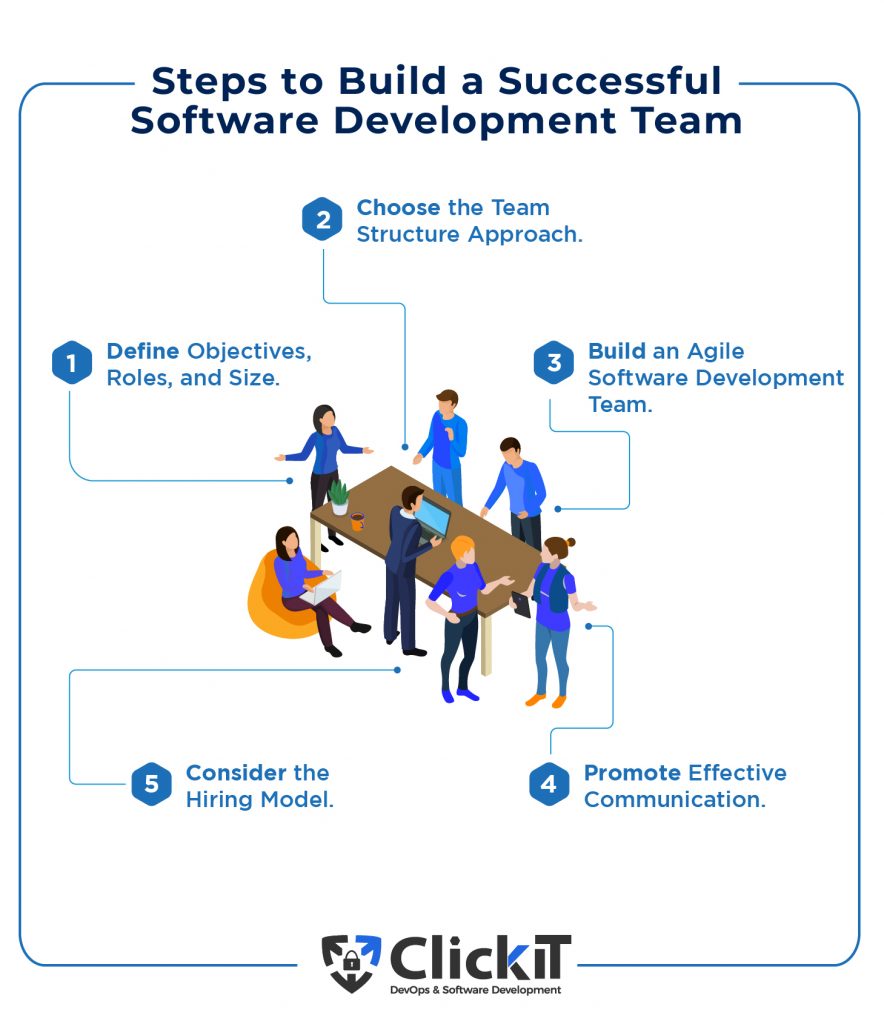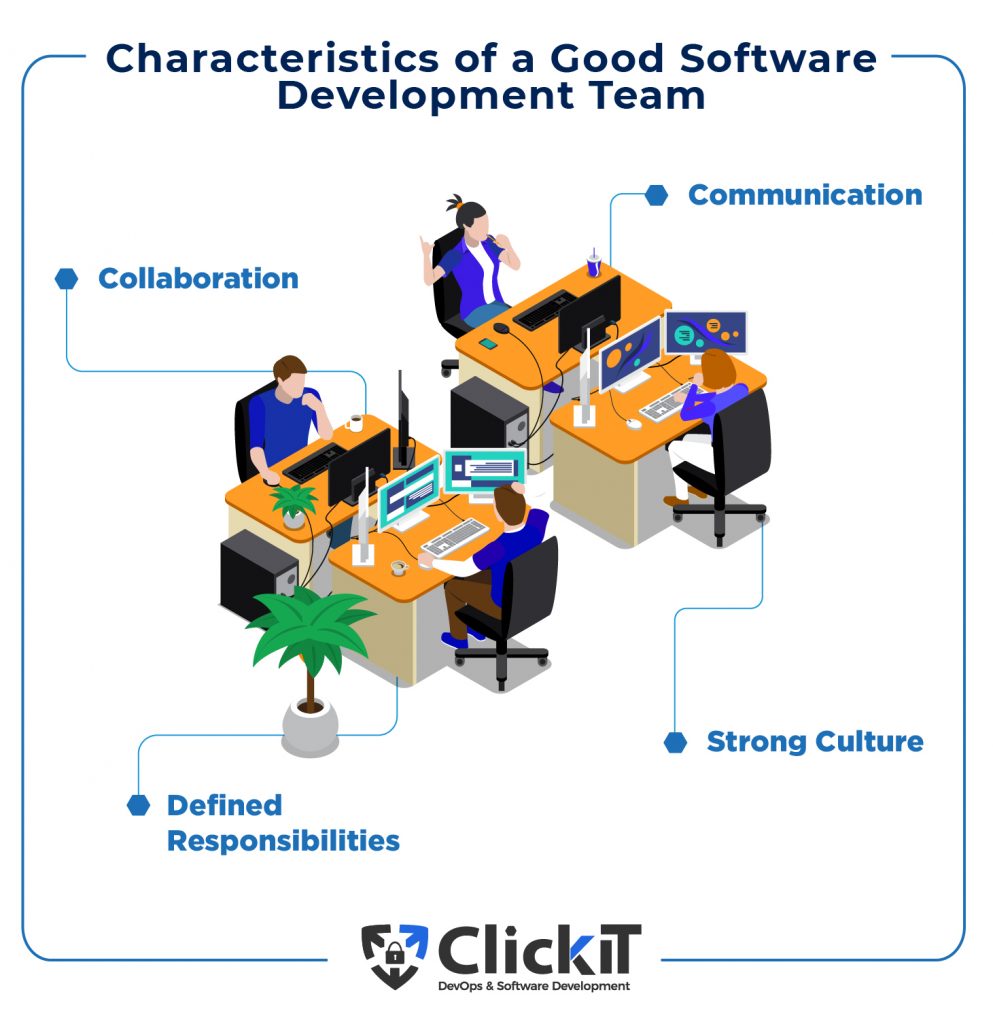Every company wants to have the most technically-gifted software developers. While that’s extremely helpful, there are other important factors for hiring or building a software development team structure that covers the software development roles to the highest level.
Skilled developers are there to be hired, but despite their proficiency, they won’t always be the ideal candidates. That’s why the best software development teams have professionals that are willing to learn and are culturally fit.
These factors ensure a cohesive and collaborative environment that fosters effective communication, teamwork, and productivity.
Fortunately, it’s not one or the other. You can get highly skilled developers with strong and complementary soft skills. This allows you to create a robust software development team structure that delivers great results.
It’s also necessary to consider the hiring model – outsourcing software development or recruiting an in-house team. Which one should you choose?
We’ll answer this and many more.
Since every decision you make when building your team directly affects project results, we’ve compiled this comprehensive guide on what you must know to hire and build the best software development team.
Table of contents
- Why Should You Build a Software Development Team?
- What Do You Need to Build a Software Development Team Structure?
- Is Building a Software Development Team Expensive?
- What Roles Do Software Development Teams Have?
- What is the Structure of a Software Development Team?
- What are the Steps to Build a Successful Software Development Team?
- What Makes a Good Software Development Team?
- Conclusion
- FAQs
Why Should You Build a Software Development Team?
If you want to build a product that’s worth it, you’re not going to do it alone. Good luck trying. You need a well-structured and balanced software development team around.
Although you might ideally favor the programming geeks, coding isn’t the only box that needs to be ticked.
In fact, more than half of a typical Agile software development team won’t need to write any code. Not bad for an Agile team, right?
Having a well-structured team plays a vital role in ensuring consistency and an organized workflow. The wealth of experience and collaborative intelligence that accompany building a team is necessary for the successful execution of projects. In addition, to having developers from different areas of competencies work on your project, software development team building enables faster and more efficient delivery.
Keep track of your team’s success; read our blog “Top 10 Software Development KPIs Your Team Needs” to learn more!
What Do You Need to Build a Software Development Team Structure?
A good understanding of the product you want to build is the starting point. Before setting up a team of developers, you must have an end in mind, the solution you want to develop. This is what determines the tools and human resources needed. If this is your first time embarking on a tech project, you will likely have difficulty figuring out your needs alone.
You need the help of a software agency to set goals and understand the technologies and talents required for your project. From having the basic information you need to build a team, with the help of a professional, you can proceed to set up a team structure. When you have developers from various areas of competencies on the discussion table, the details of the product will be discussed, as well the recommendations made regarding project requirements.
Everything revolves around money. A ‘healthy’ budget is a must-have for software development team building. It is challenging to know the financial requirements of a project from the beginning. However, you need a substantial sum of money to recruit a standard team of coders. You can take a look at our slideshow about the best tips to create an IT team.

Is Building a Software Development Team Expensive?
Generally, having an organized group of developers work on your project is expensive. That said, the actual amount you need to manage a team is dependent on a range of factors, including size and type of project, people on your team, and your negotiation skills. They play leading roles in determining the cost of the project.
The size and type of product you want determine the tools, skillset, and the number of developers you will need. If you plan to work with specialists and high-end developers, the cost will be higher when compared with the cost of recruiting generalists and low-level engineers. A small project requires a small group of engineers. The opposite is true. Consequently, you will spend more money to build a product that needs an extensive number of developers.
Development time frame is a leading cost determinant. Logically, a project that takes six months to conclude is expected to cost more than a similar product developed within three months. More time translates to more money, in most cases. Having your product delivered as fast as possible is an effective money-saving strategy. Finally, you can significantly reduce costs by putting forward good negotiation skills.
What Roles Do Software Development Teams Have?
You need key roles to hire a Software development team. The software development roles represent areas where you need skilled and experienced engineers. Every role is crucial and necessary for the effective development of your product.
Each software development team has roles fundamental to the project’s success. They may become involved right from the project’s inception or contribute during implementation, testing, deployment, maintenance, or audit.
These professionals collectively create a well-rounded team, establishing a strong foundation for success. While their contributions will ultimately depend on the team’s objectives and structure, their core responsibilities remain.
Below, we’ll highlight the most important software development team roles and outline what they bring to your organization.
- Product Owner
- Project Manager
- Software Architect
- Software Engineers (Backend and Frontend)
- DevOps Engineer
- QA Specialist
- UI/UX Engineer
- Business Analyst
- Software Testing Engineer

Product Owner
The product owner represents the customer’s voice and acts as the middle person between stakeholders and the development team. The goal is to ensure the product vision is maintained and provide the developers’ guidance or input for product success. Product owners serve the customer’s interest (the actual owner of the project), ensuring there is order and enforcing deadlines and product quality.
Responsibilities of a Product Owner in a Software Development Team
Due to their role, the product owner has an in-depth knowledge of the product, customer expectations, and potential business value. Hence, they act as a liaison between dev teams and stakeholders.
In a software development team, a product owner must steer the project to success and adapt to the ever-changing market demands.
Here are the core responsibilities of a product owner:
- Define the product vision and goals, and communicate them to the development team and stakeholders. This also includes clear and well-defined user stories.
- Leverage your team’s Agile methodologies and frameworks like Scrum, Kanban, or Lean to provide flexibility for developers. Furthermore, said Agile methodologies maximize business ROI, and ensure continuous improvement of a team.
- Sets and prioritizes the product backlog, scope, and features based on customer needs and business value.
- Participates in sprint planning and reviews with the project manager and developers.
- Monitors the project process, identifying potential bottlenecks and addressing them up until the release of the minimum viable product (MVP) and afterward.
- Collaborates with the stakeholders, gathers feedback, and relays it to the development team to be incorporated into the product.
Project Manager
As the name implies, a project manager (PM) is a software development team role that has the fundamental responsibility of ensuring your project is delivered efficiently, on time, and within budget. With this purpose, project managers leverage available resources to prevent anything that can negatively impact the project.
Keeping the product development process on track can be challenging due to unpredictable factors that can cause chaos. However, a project manager takes proactive measures to prevent or minimize the effects of problems.
Ideally, this professional breaks the entire software development process into modular parts like tasks and sub-tasks.
The project manager’s primary responsibility is controlling the software project. They know the who, what, where, when, and why of the software plan
Responsibilities of a Project Manager
- The project manager is responsible for the organization, supervision, and coordination from execution to delivery. They keep the team close-knit, ensuring teamwork to achieve the project’s goals.
- Establishes clearly-defined goals for each developer and software development team. They accomplish this by delegating tasks effectively, ensuring teams adhere to established quality standards and are on track based on the project’s roadmap.
- Defines team and individual milestones and regularly provides performance appraisals or reviews for motivation.
- Allocates and manages resources like budget, time, and human resources to ensure efficient usage and project completion.
- Identifies potential risks to the project and develops strategies to mitigate them and reduce the chances of delays or failure.
- Facilitates open communication and collaboration among team members, including conflict resolution.
Read our blog, Product Owner vs Product Manager.
Software Architect
The software architect is responsible for planning and organizing the software system. This professional creates high-level design and framework specifications. Therefore, they choose the best tools, technologies, frameworks, and platforms suitable for the project
Responsibilities of a Software Architect
- Making critical architectural decisions based on non-functional requirements, defining coding standards, and selecting suitable tools and platforms.
- Reviewing code for quality, clarity, and simplicity to ensure maintainable software.
- Demonstrating expertise in programming, people management, communication, psychology, and financial awareness.
- Providing technical support throughout the project lifecycle, from inception to release, development, and enhancements.
- Tackling complex non-functional requirements and implementing innovative solutions that drive continuous improvement.
- Identifying core needs, offering high-level solution designs, and mitigating risks and constraints.
- Mentoring developers, enforcing quality standards, and maintaining effective communication with stakeholders.
Software Engineers
Software engineers can either be frontend developers or backend developers. Both software development team roles are required for your project.
Front-end Developer Software Developer
A front-end software developer plays a vital role in building the user-facing aspect of an application or website. Their expertise lies in writing the code for visually appealing and interactive user interfaces that users directly interact with.
The typical front-end developer’s tech stack involves HTML, CSS, and JavaScript. They will also need knowledge of front-end frameworks like React.js, Angular, or Vue.js.
Since front-end elements will need to be integrated into the back-end, front-end developers with knowledge of server-side programming can come in handy.
Here are some of their likely responsibilities.
- Write clean and efficient code.
- Implement visually appealing user interface designs that are also responsive and provide a seamless user experience. This also includes cross-browser compatibility across multiple devices and screen sizes.
- Communicate and collaborate with UI/UX designers to bring their designs to life and back-end developers to integrate front-end elements with the back-end.
- Test and debug front-end code to maintain quality and high performance.
- Report to the project manager with progress reports and any issues.
- Participate in code reviews and maintain code documentation
- Optimize website performance and loading speed.
Back-end Developer
A back-end developer works behind the scenes. Moreover, they ensure that the operations your users execute on the front-end work as intended. This means they will code sophisticated algorithms, program logic, and manage the database application to ensure it runs efficiently.
Back-end developers will also build and implement external integrations like APIs, security features, etc.
Here is what their day-to-day responsibilities look like:
- Develop clean and robust server-side code, implementing complex algorithms and data structures to handle application logic efficiently.
- Build and manage APIs (Application Programming Interfaces) to facilitate data exchange between the front-end and back-end components.
- Communicate and collaborate with front-end developers to seamlessly integrate their work with the back-end.
- Work with DevOps teams to deploy and maintain the application on servers or cloud platforms.
- Design and maintain databases, ensuring data integrity and optimal query performance.
- Optimize back-end performance, scalability, and response times to handle increasing user demands.
- Implement security measures to protect sensitive user data and prevent unauthorized access.
- Conduct thorough testing and debugging of back-end code to identify and resolve any problems.
Full Stack Developer
The full-stack developer can develop both client and server software. They have an extensive skillset that covers front-end and back-end development. This means they’re more likely to oversee other developers in a software development team structure.
Their responsibilities include:
- Developing front-end and back-end website architecture and applications.
- Building servers and databases
- Designing, developing, and integrating APIs
- Ensuring operating systems like Windows, macOS, and Linux support applications.
- Ensure scalability, performance optimization, and continuous improvement.
- Build responsive design, user stories, and facilitate better user experience.
DevOps Engineer
A DevOps engineer’s software development team role is to ensure 24/7 uptime and prevent downtime. After launching an application, in most cases, how the program responds to traffic during the testing phase is different from what happens when many users start placing demands on the software. Typically, load time increases, and the application slows down with increased traffic.
In extreme cases, crashes happen due to poor architecture, insufficient infrastructure, and poor optimization. This is where DevOps specialists come in. They are responsible for solving the challenges above and ensuring 24/7 uptime, optimal speed, scalability, security, and accessibility for users worldwide. Our blog, the ultimate guide to hiring a DevOps engineer, can help you choose an adequate DevOps engineer.
Responsibilities of DevOps engineer
- Implementing and maintaining continuous integration and continuous deployment (CI/CD) pipelines. This allows efficient automated processes that ensure the team can integrate code changes, run tests, and deploy updates faster.
- Developing and managing infrastructure automation (IaC) to automate provisioning and scaling of infrastructure resources.
- Setting up monitoring and logging systems to monitor application performance
- Coordinating and managing software releases for organized release cycles and smoother rollback procedures.
- Ensuring software security and compliance with industry standards.
- Facilitating collaboration and communication among the development and operations teams.
- Participating in troubleshooting and incident management procedures.
Quality Assurance (QA) Specialist
It’s almost impossible to avoid errors during software development, especially in more complex projects.
While your developers will likely test and debug their code, the best practice is to hire an independent set of eyes that not only makes the code bug-free but meets the quality standards set by customers, market dynamics, and compliance requirements.
This is the role of the Quality Assurance Specialist in your software development team.
Ideally, your QA specialist will come into the picture during the testing and debugging phase after the developers have completed the development.
However, QAs can also be involved earlier in the requirements gathering and designing stage, especially in more iterative and Agile team methodologies like Scrum. As we mentioned, other Agile methodologies and frameworks teams use are Kanban or Lean.
This approach is called Early QA.
Responsibilities of a Quality Assurance Specialist
Here’s what a QA specialist will bring to your software development team:
- Collaborate closely with the development team to understand the requirements and ensure alignment during development.
- Create and execute comprehensive test plans.
- Thoroughly test the software to identify and document bugs, then report the issues to the development team for remediation.
- Conduct regular regression tests to verify new changes and updates don’t introduce fresh problems to the existing functionalities.
- Conduct performance and loading testing to ensure the software can handle user demands.
- Be continuously involved to ensure improvement and overall software efficiency based on changing customer expectations.
UI/UX Engineer
The UI/UX Designer designs the user interface and user experience. They are focused on the visuals – aesthetic appeal and user experience. Accordingly, this professional maps out the user journey and crafts intuitive designs that enhance user satisfaction and engagement.
Like every other software development team role, collaboration is critical for UI/UX Designers. They work closely with the development team to ensure their design aligns with your project’s requirements and objectives.
This professional will need to understand user needs, preferences, and expectations. The UI/UX Designer has the following responsibilities
Responsibilities of UI/UX Engineer
- Conduct user research and usability testing to validate design decisions and iterate based on feedback.
- Engage in collaborative efforts with cross-functional teams to collect requirements and synchronize design with development endeavors.
- Create visually appealing and user-friendly interface designs that enhance the overall user experience.
- Ensure designs are responsive and accessible across various devices and screen sizes.
- Work with developers to implement the UI/UX designs into the final product, maintaining design integrity.
- Create interactive prototypes to showcase design concepts and gather input from stakeholders.
- In some software development team structures, the UI/UX Designer may need to use front-end programming languages like HTML, CSS, and JavaScript.
Business Analyst
Most products fail not because of technical problems but due to unprofitable business approaches. Having a solid and verified, viable business model behind your project is as important, if not more, as developing a high-quality product. Hence, the role of a business analyst is to analyze and verify your business idea to ensure you embark on a potentially profitable project.
The primary goal is to help you decide if your idea is worth investing in. A study has shown that spending 8 to 10% of the time and money on business analysis increases the chances of project success. Thus, a business analyst helps you build the right product at the right time, meet client needs, and create a consistent solution with your business model and long-term interests.
Responsibilities of a Business Analyst
- Conducting thorough market research to understand current industry trends, potential business opportunities, and possible challenges.
- Engaging with clients and product owners to understand their specific business needs.
- Translating business needs into clear and comprehensive requirements for the development team.
- Collaborating with project managers and architects to define the project scope accurately.
- Documenting detailed business requirements to provide a solid foundation for the development process.
- Maintaining open and effective communication with all relevant stakeholders throughout the project lifecycle.
Software Testing Engineer
Before deploying your software, it’s important to ensure it works. Software Testing Engineers develop, design, and implement test procedures that ensure the software functions as expected.
They do this to identify and resolve any bugs or errors with functionality and user experience before the software is released to the public.
In their software development team role, testing engineers will perform the following key responsibilities.
Responsibilities of a Software Testing Engineer
- Design and implement test procedures to evaluate the software and identify and fix bugs. This includes performance, security, compatibility, and user acceptance testing (UAT).
- Leverage virtualization technologies like KVM, VMware, and Virt-Manager to oversee and maintain a Linux virtual machine farm.
- Work closely with the developers and quality assurance specialists to ensure the product meets the required quality standards.
- Assess risk, regulatory considerations, and business requirements to optimize the Quality Control (QC) process.
- Use project tracking tools like Bugzilla to perform test case defect reporting and documentation.
- Develop a robust UI automation using a range of programming languages and frameworks like Python, Java, and Selenium for comprehensive and efficient testing.
What is the Structure of a Software Development Team?
There are three approaches to a software development team structure:
- The Generalist Team: This is a team of professionals with a broad range of skills and experience, but none has in-depth expertise in a specific branch.
- Specialist Structure: Each team member in this structure knows their niche or technology for their jobs but may be lacking in general development issues.
- Hybrid Team: This is a combination of specialists and generalists. Hence, they can work on a project as a whole and narrow it down to each member’s specialisation when necessary.
The project’s complexity, the development methodology for a team (waterfall or Agile), your budget, and the project deadline all influence the type of structure you choose.
Despite these factors, here are some ideas on what your software development team structure may look like:
| Project Stage | Team Size | Team Roles |
| Discovery/Proof of Concept | 2 to 5 | The Product Owner and Business Analyst are critical here. Other roles that may be needed depending on project size, methodology, and budget include Software Architect, UI/UX Designer, and Project Manager. |
| Requirements Gathering and Analysis | At least 3 | Product Owner, Business Analyst, UI/UX Designer. A front-end developer is optional, particularly if they’re skilled in UI/UX, and the budget allows this flexibility. |
| Design and Planning | Up to 4 | Product Owner, Business Analyst, Software Architect, and UI/UX Designer. |
| MVP Planning and Development | 6+ | Product Owner, Project Manager, Business Analyst, UI/UX Designer, Software Engineers (front-end, back-end, and full-stack), and software test engineers. QA Specialist is optional. |
| Software Development | In Agile, the team may be up to 9 specialists. Unlike Agile teams, waterfall has no team size limit. This largely depends on the project’s complexity and budget. | Product Owner, Project Manager, Business Analyst, Software Architect, UI/UX Designer, and Software Engineers. |
| Testing and Quality Assurance | 6+ | Product Owner, Project Manager, Business Analyst, QA Specialist, Software Testing Engineers, and Software Engineers. |
| Deployment and Release | 5+ | Product Owner, Project Manager, Business Analyst, Software Engineers, and DevOps Engineer. |
| Maintenance and Support | 5+ | Product Owner, Project Manager, Business Analyst, Software Engineers, and DevOps Engineer. |
What are the Steps to Build a Successful Software Development Team?
It’s important to have a structured team that is self-organizing and productive. Subsequently, if you’re trying to build or hire a software development team, here are key steps to consider:

Define Objectives, Roles, and Size
The first step is evaluating your project. This includes the complexity, business goals, budget, and deadlines. Analyzing these prerequisites allows you to determine the team’s size and roles.
Agile and Scrum teams generally have between 3 to 9 members. Many software engineering managers believe 7 is the ideal size for an Agile team. On the other hand, waterfall teams are larger than Agile teams and could be more than 15 professionals due to their hierarchical nature.
Choose the Appropriate Team Structure Approach
Does the project require a generalist, specialist, or hybrid team? How many software engineers do you need?
To decide, you should weigh each approach’s pros and cons.
For example, generalists may know something about everything, but there may be risks because they lack deep expertise. This means you may have to hire a specialist at some point in the project.
A generalist team works fine if your project’s complexity is small to medium.
On the other hand, specialist teams can deliver high-quality work in their niche. They are excellent for projects that require domain expertise, e.g., building a fintech app, healthcare software, gaming, etc.
This is because their technical skills are most relevant to the niche. However, they may struggle with communication and collaboration.
Additionally, hybrid teams may be expensive to build. There may also be potential management issues due to the combination of different people with varying software development approaches.
However, this is the best structure for large-scale and complex projects with strict deadlines if you have the budget and a strong project manager.
Build an Agile Software Development Team
Agile is a software engineering principle that comes highly recommended for most projects and teams.
Embracing the agile methodology enhances your business analyst and team’s flexibility. This, as a result, enables seamless adaptation to unforeseen changes without disrupting the entire process.
While building an agile software development team, two common methodologies are Scrum and Kanban.
Kanban emphasizes real-time communication and complete work transparency, relying heavily on visualization through the Kanban board. This visual representation aids the team in tracking progress and identifying and overcoming obstacles.
On the other hand, Scrum, the most popular Agile framework for a team, involves breaking down extensive projects into manageable sprints. The sprints resulting from said Agile team’s framework are reviewed and adapted regularly. In this case, you may need a Scrum master for your Agile team.
Regardless of the chosen framework, incorporating agile principles empowers your team to deliver faster and more efficiently. Becoming an agile team has its benefits!
Promote Effective Communication and Seamless Collaboration
Communication is one of the most critical skills in a software development team. You’re assembling a team of people from different backgrounds that will work together to achieve a common goal. Keep this in mind when you hire a software development team!
The client will also pass messages across, so active listening is necessary. It’s essential to look out for great professionals to work with and communicate effectively.
You should also set up project management software like Jira and Trello to provide more transparency. Messaging apps and video conferencing apps are also important, especially during crisis management and real-time communication. You can also use tools like Guru to keep your company’s information and policies up-to-date to improve your team’s workflow.
Watch our video on the importance of effective communication in software development
Consider the Hiring Model
In-house teams offer close collaboration and immediate access, fostering a strong company culture. However, to hire a software development team this way is significantly expensive. It also requires constant training, and you may have limited expertise.
Outsourcing to an external software team significantly saves costs, gives access to specialists, and leads to a faster time-to-market. Depending on your project needs, you can also scale up or down at any time. However, since they’re external, there may be communication gaps due to different time zones, cultures, and misinterpretations.
So, which one should you choose? It all depends on your project’s complexity and budget.
But what if you enjoy the positives of in-house and outsourced software development without the cons?
This is where a nearshore software company like ClickIT comes in.
With nearshore outsourcing, you can harness our top-tier talent pool from a neighboring region like Mexico, ensuring cost-effectiveness, cultural alignment, and similar time zones.
Because of this, ClickIT should be your trusted nearshore partner. Our expertise in software development, DevOps, and cloud solutions accelerates innovation, reduces costs, and drives successful software development.
What Makes a Good Software Development Team?
There are unique characteristics that make a software development team stand out: communication, collaboration, defined responsibilities, and strong culture. So, when you’re setting up an application and you hire a software development team, take a step further to ensure these values are established
Communication
The structure of communication is one of the heartbeats of every software development team. Thus, the team and stakeholders should be clear on passing information across and within the sub-teams from the onset.
The project owner plays a vital role when it comes to communication. Stakeholders need to stay informed on the progress of the project, and there should be a robust communication network to ensure no developer strays from the goals of the project.
Consequently, it takes good communication to organize a team and keep it on course throughout the product development lifecycle.
Collaboration
Even though there are various software development team roles, none exist in isolation. Areas of competencies are interwoven and interdependent. Consequently, collaboration is required to harness the full potential of your team.
When you hire a software development team, consider implementing modern collaboration tools, so developers can efficiently work together and share files in real-time. The project manager ensures good collaborative workflow among and within sub-teams. You can visit our blog Remote Collaboration for 2022 to learn more about working efficiently with your remote team.
Defined Responsibilities
Every team member should be assigned responsibilities with proper documentation. Being clear on who does what is necessary for efficient, fast delivery and accountability. On the contrary, when there are no defined responsibilities, delays are inevitable, and things are bound to go wrong.
Strong Culture
There is a need for a solid corporate culture that determines the organizational principles of the team. Hence, the ability of developers to adopt team culture is an important skill you need to build a successful project group.

Conclusion
You need a good software development team to build a high-quality product. Given the complexity of software development, a team comprises developers proficient in different areas of application development. Nonetheless, the size of your software development team structure is determined by key factors, like the type of software you want to build, features, and user base. So, pay close attention when you hire a software development team!
The software development team roles outlined above are exhaustive. Depending on the demands of your project, there are other areas of competencies that can be created. For instance, there are security specialists, performance testers, and more distinguishable specialists. We recommend talking with a development agency so your needs can be analyzed, and the ideal team composition will be proposed based on your goals and budget.
Are you thinking of working with a software development company? Look no further than ClickIT, the best DevOps Nearshore team. We stand out because we help businesses to build robust, secure, and high-quality software-based applications designed to increase productivity and efficiency. We also help you to hire a software development team that turns your dreams into reality.

FAQs
Consult a software development agency to help you build a development team. Then, a professional will analyze your needs and recommend the best team composition based on your goals and budget. With their help, you can hire a software development team that meets your requirements.
Generally, a software development team consists of a product owner, project manager, software architect, frontend developer, backend developer, DevOps specialist, QA engineer, and UI/UX designer. However, when you hire a software development team, you can include other specialists not mentioned here.
Great communication, collaboration, defined responsibilities, and strong culture make a good development team. In addition, team members should have the skills and experience to deliver a high-quality product on time and within budget.
To build a strong team, you must institute a robust corporate culture. Additionally, hire a well-trained and experienced project manager to organize the team and ensure everyone continually grinds towards the common goals.
Define responsibilities and fragment the team into sub-teams. Afterward, assign a general project manager and sub-team project managers. Use project management and collaboration tools to streamline every process and enable team members to be accountable and committed.








